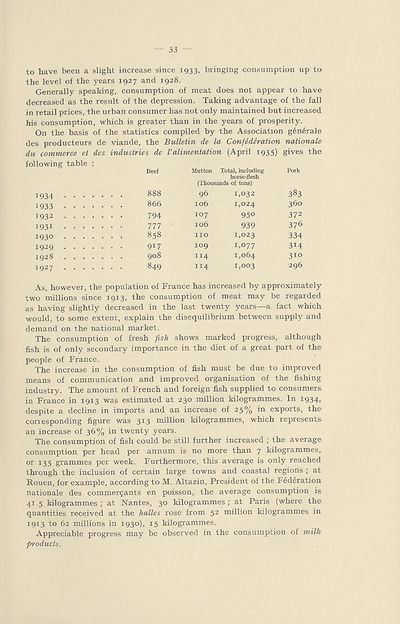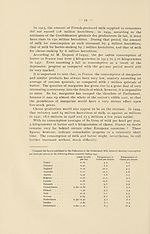Download files
Complete book:
Individual page:
Thumbnail gallery: Grid view | List view

33 —
to have been a slight increase since 1933, bringing consumption up to
the level of the years 1927 and 1928.
Generally speaking, consumption of meat does not appear to have
decreased as the result of the depression. Taking advantage of the fall
in retail prices, the urban consumer has not only maintained but increased
his consumption, which is greater than in the years of prosperity.
On the basis of the statistics compiled by the Association generale
des producteurs de viande, the Bulletin de la Confederation nationale
du commerce et des industries de Valimentation (April 1935) gives the
following table :
1934
1933
1932
I931
1930
1929
1928
1927
Beef
888
866
794
777
858
917
908
849
Mutton Total, including
horse-flesh
(Thousands of tons)
96 1,032
106 1,024
107 950
106 939
IIO 1,023
109 I,077
114 1,064
114 1,003
Pork
383
360
372
376
334
3i4
310
296
As, however, the population of France has increased by approximately
two millions since 1913, the consumption of meat may be regarded
as having slightly decreased in the last twenty years—a fact which
would, to some extent, explain the disequilibrium between supply and
demand on the national market.
The consumption of fresh fish shows marked progress, although
fish is of only secondary importance in the diet of a great part of the
people of France.
The increase in the consumption of fish must be due to improved
means of communication and improved organisation of the fishing
industry. The amount of French and foreign fish supplied to consumers
in France in 1913 was estimated at 230 million kilogrammes. In 1934,
despite a decline in imports and an increase of 25% in exports, the
corresponding figure was 3x3 million kilogrammes, which represents-
an increase of 36% in twenty years.
The consumption of fish could be still further increased ; the average
consumption per head per annum is no more than 7 kilogrammes,
or 135 grammes per week. Furthermore, this average is only reached
through the inclusion of certain large towns and coastal regions ; at
Rouen, for example, according to M. Altazin, President of the Federation
nationale des commergants en poisson, the average consumption is
41.5 kilogrammes ; at Nantes, 30 kilogrammes ; at Paris (where the
quantities received at the halles rose from 52 million kilogrammes in
1913 to 62 millions in 1930), 15 kilogrammes.
Appreciable progress may be observed in the consumption of milk
products.
to have been a slight increase since 1933, bringing consumption up to
the level of the years 1927 and 1928.
Generally speaking, consumption of meat does not appear to have
decreased as the result of the depression. Taking advantage of the fall
in retail prices, the urban consumer has not only maintained but increased
his consumption, which is greater than in the years of prosperity.
On the basis of the statistics compiled by the Association generale
des producteurs de viande, the Bulletin de la Confederation nationale
du commerce et des industries de Valimentation (April 1935) gives the
following table :
1934
1933
1932
I931
1930
1929
1928
1927
Beef
888
866
794
777
858
917
908
849
Mutton Total, including
horse-flesh
(Thousands of tons)
96 1,032
106 1,024
107 950
106 939
IIO 1,023
109 I,077
114 1,064
114 1,003
Pork
383
360
372
376
334
3i4
310
296
As, however, the population of France has increased by approximately
two millions since 1913, the consumption of meat may be regarded
as having slightly decreased in the last twenty years—a fact which
would, to some extent, explain the disequilibrium between supply and
demand on the national market.
The consumption of fresh fish shows marked progress, although
fish is of only secondary importance in the diet of a great part of the
people of France.
The increase in the consumption of fish must be due to improved
means of communication and improved organisation of the fishing
industry. The amount of French and foreign fish supplied to consumers
in France in 1913 was estimated at 230 million kilogrammes. In 1934,
despite a decline in imports and an increase of 25% in exports, the
corresponding figure was 3x3 million kilogrammes, which represents-
an increase of 36% in twenty years.
The consumption of fish could be still further increased ; the average
consumption per head per annum is no more than 7 kilogrammes,
or 135 grammes per week. Furthermore, this average is only reached
through the inclusion of certain large towns and coastal regions ; at
Rouen, for example, according to M. Altazin, President of the Federation
nationale des commergants en poisson, the average consumption is
41.5 kilogrammes ; at Nantes, 30 kilogrammes ; at Paris (where the
quantities received at the halles rose from 52 million kilogrammes in
1913 to 62 millions in 1930), 15 kilogrammes.
Appreciable progress may be observed in the consumption of milk
products.
Set display mode to:
![]() Universal Viewer |
Universal Viewer | ![]() Mirador |
Large image | Transcription
Mirador |
Large image | Transcription
Images and transcriptions on this page, including medium image downloads, may be used under the Creative Commons Attribution 4.0 International Licence unless otherwise stated. ![]()
| League of Nations > Economic and financial section > Problem of nutrition > (35) |
|---|
| Permanent URL | https://digital.nls.uk/190924217 |
|---|
| Shelfmark | LN.II |
|---|
| Description | Over 1,200 documents from the non-political organs of the League of Nations that dealt with health, disarmament, economic and financial matters for the duration of the League (1919-1945). Also online are statistical bulletins, essential facts, and an overview of the League by the first Secretary General, Sir Eric Drummond. These items are part of the Official Publications collection at the National Library of Scotland. |
|---|---|
| Additional NLS resources: |
|

